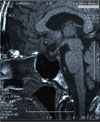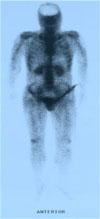Abstract
Rhabdomyolysis is the consequence of extensive muscle injury with the release of muscle cell constituents into plasma. It can arise from trauma and also from a variety of nontraumatic causes. Trauma, drugs, toxins and infection are the major causes of rhabdomyolysis, but it is rarely associated with metabolic disorders such as severe electrolyte disturbance, diabetic ketoacidosis, hyperosmolar nonketotic coma, hypothyroidism and thyrotoxicosis. There have been several reported cases of metabolic rhabdomyolysis, but panhypopituitarism as a cause has never been identified. We experienced a case of acute rhabdomyolysis associated with panhypopituitarism. Thus, So we report this case with the review of related literature. Metabolic disorder is a rare cause of rhabdomyolysis, but it should always be considered in a patient having and unexplained increased of the creatine kinase concentration.
Figures and Tables
References
1. Gabow RA, Kaehny WD, Kelleher SP. The spectrum of rhabdomyolysis. Medicine. 1982. 61:141–152.
2. Honda N. Acute renal failure and rhadomyolysis. Kidney Int. 1983. 23:888–898.
3. Allison RC, Bedsole DL. The other medical cause of rhabdomyolysis. Am J Med Sci. 2003. 326:79–88.
5. Lord GM, Scott J, Pusey CD, Rees AJ, Walport MJ, Davies KA, Bulpitt C, Bloom SR, Muntoni FM. Diabetes and rhabdomyolysis. A rare complication of a common disease. Br Med J. 1993. 307:1126–1128.
6. Keung CB, Li PKT, Lui SF, Lai KN. Acute renal failure caused by rhabdomyolysis due to diabetic hyperosmolar nonketotic coma. Ren Fail. 1992. 14:81.
7. Bennett WR, Huston DP. Rhabdomyolysis in thyroid storm. Am J Med. 1984. 77:733–735.
8. Marshall RJ, McCaughey WTE. Hypothermic myxedema coma with muscle damage and acute renal tubular necrosis. Lancet. 1956. 754.
9. Halverson PB, Kozin F, Ryan LM, Sulaiman AR. Rhabdomyolysis and renal failure in hypothyrodism. Ann J Med. 1979. 91:57–58.
15. Adler S. Hyponatremia and rhabdomyolysis: a possible relationship. South Med J. 1980. 73:511–513.
17. Knochel JP, Carter NW. The role of muscle cell injury in the pathogenesis of acute renal failure after exercise. Kid Int Suppl. 1976. 6:S58–S64.
18. Thacker AK, Agrawal D, Sarkari NB. Bilateral anterior tibial compartment syndrome in association with hypothyroidism. Postgrad Med J. 1993. 69:881–883.
21. Fliers E, Wiersinga WM. Myxedema Coma. Rev Endocr Metab Disord. 2003. 4:137–141.




 PDF
PDF ePub
ePub Citation
Citation Print
Print






 XML Download
XML Download